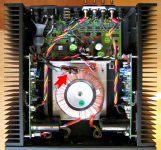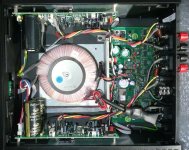Inform the audience about brand, model, &c. Much appreciated.
Many (but not all!) multi-voltage transformers of this kind have three wires: brown, black and blue.
Most often (but not always!) you find brown is 220/230/240Vac, black 110/115/120Vac, blue the neutral return.
A spare brown makes me very cautious. It is live voltages anyhow, so be carefull (use rubber gloves when fumbling with the open wires).
Many (but not all!) multi-voltage transformers of this kind have three wires: brown, black and blue.
Most often (but not always!) you find brown is 220/230/240Vac, black 110/115/120Vac, blue the neutral return.
A spare brown makes me very cautious. It is live voltages anyhow, so be carefull (use rubber gloves when fumbling with the open wires).
It is a Meridian 551 integrated. No schematic is included in the manual. The only schematics I found were 556 and 557.
file:///C:/Users/vigna/Downloads/hfe_meridian_551_user_guide_en-2.pdf
file:///C:/Users/vigna/Downloads/hfe_meridian_551_user_guide_en-2.pdf
It is available on hifi engine, library, Meridian 551. I tried the link and it works fine in my PC.
There are many users here who encounters problems when accessing the engine, or are not able / allowed to create an account.
Posting it here as an attachment will be very helpfull.
Posting it here as an attachment will be very helpfull.
Just in case your existing transformer hasn't been wired to accept 110VAC...since moving from the states long ago...I had to buy a slew of 220VAC to 110VAC autotransformers...from 50W to a monster 3K+ version to run a US spec clothes-dryer...in fifteen plus years of nearly continuous use, only one has failed...
-------------------------------------------------------------------------------------------------------------------------------------------------------------Rick...
-------------------------------------------------------------------------------------------------------------------------------------------------------------Rick...
Some Japanese power supplies have a 110V tap, that's why I thought it could be possible with a British product. It’s cheaper for manufacturers to have 10,000 transformers made with spare windings than have to get a bunch of different specs made, but you also have to bear in mind that but the bigger companies purposefully do not, so gray market stuff can't be sold around the globe.
Did I claim that?That's not a schematic or service manual.
It's only a screenshot from the UserMan.
Trace the primary windings, measure the resistance in low ohms range with a good meter.
The 110V winding should read half or so of the 230V winding.
That's it.
Provided it exists.
Japanese sets for domestic Japan and USA / Europe market were sometimes single primary windings, those that were sold in duty free places like Dubai and Hong Kong, and the American Forces bases every where had multiple voltage primaries, for ease of use... you never knew where it would end up, and it may be moved, for example a US Army person buys a set in Germany, then takes it home after he / she is rotated back to base.
The 110V winding should read half or so of the 230V winding.
That's it.
Provided it exists.
Japanese sets for domestic Japan and USA / Europe market were sometimes single primary windings, those that were sold in duty free places like Dubai and Hong Kong, and the American Forces bases every where had multiple voltage primaries, for ease of use... you never knew where it would end up, and it may be moved, for example a US Army person buys a set in Germany, then takes it home after he / she is rotated back to base.
There are some images of the insides of versions of Meridian 551 here:
https://hifi-inside.com/hifi-ht/meridian/integrated-amplifier
https://hifi-inside.com/hifi-ht/meridian/integrated-amplifier
Attachments
Seems to be single voltage unit in the pictures, from the ID plate.
Use a 500 VA transformer, and do not fuss, the toroids will not be troublesome at 60 Hz.
Of course, it says Made in England, you never know if the transformer and the rest are 'over cute' designs by some wise guy.
Then all bets are off.
The wire pointed to in the arrow in the first picture in Post #1 is coming from the mains inlet, it is not clear if two or three wires are bundled together.
If it is three wires, measure them, you might get lucky, the transformer may have been a ready unit made abroad, with 110 / 220 windings.
There are two sets of taps for the two channels, a third set of wires, near the mains inlet, seems to be either for a fuse set / protection circuit, or the taps for the lower voltage pre-amplifier section.
But I would simply use a transformer, having first decided whether this unit was worth the investment.
And transformers are fairly reliable if they are used with care, might come in handy for any other equipment you got from England, provided you stay within its rating.
Get one with an Earthed metal or totally insulated box for safety.
Use a 500 VA transformer, and do not fuss, the toroids will not be troublesome at 60 Hz.
Of course, it says Made in England, you never know if the transformer and the rest are 'over cute' designs by some wise guy.
Then all bets are off.
The wire pointed to in the arrow in the first picture in Post #1 is coming from the mains inlet, it is not clear if two or three wires are bundled together.
If it is three wires, measure them, you might get lucky, the transformer may have been a ready unit made abroad, with 110 / 220 windings.
There are two sets of taps for the two channels, a third set of wires, near the mains inlet, seems to be either for a fuse set / protection circuit, or the taps for the lower voltage pre-amplifier section.
But I would simply use a transformer, having first decided whether this unit was worth the investment.
And transformers are fairly reliable if they are used with care, might come in handy for any other equipment you got from England, provided you stay within its rating.
Get one with an Earthed metal or totally insulated box for safety.
Last edited:
Interesting but confusing posts. The chap is talking about 568 surround sound processor and 588 CD player series that do not use toroidal transformers but interesting anyway.
https://www.meridianunplugged.com/ubbthreads/ubbthreads.php?ubb=showflat&Number=250688&page=all
https://www.meridianunplugged.com/ubbthreads/ubbthreads.php?ubb=showflat&Number=250688&page=all
- Home
- Amplifiers
- Power Supplies
- 230V to 110V


